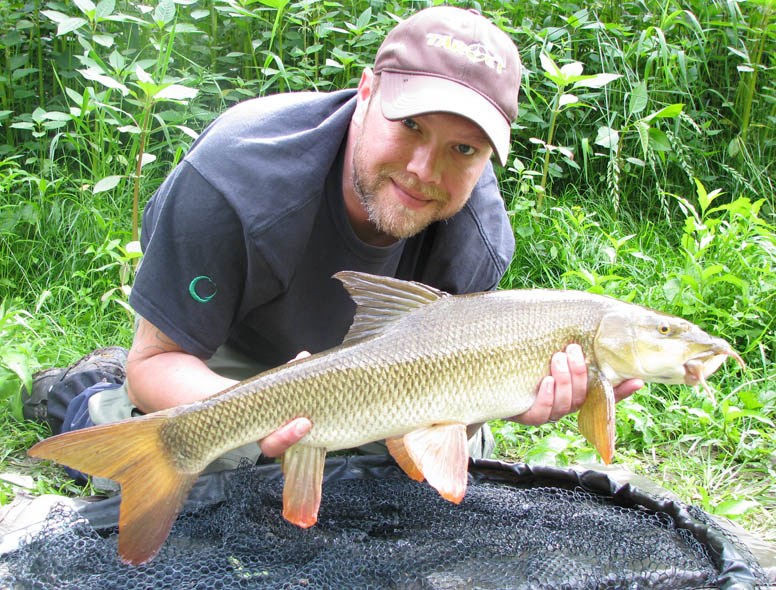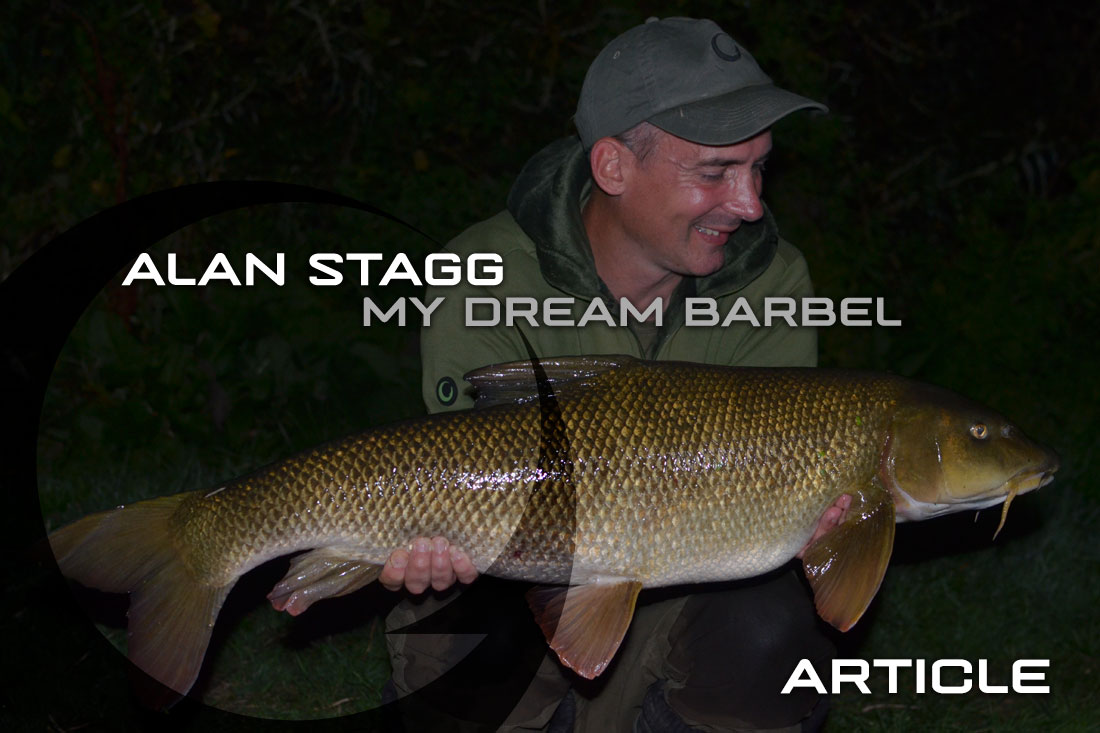Picture the scene: Low water levels, high light levels, barbel that have probably been hammered in the weeks leading up to my visit, a complete change of scenery, totally varied aquatic topography and a few as yet unknown technical challenges thrown in for good measure. All in all a perfect set of circumstances to charge the grey matter with conjuring up some alternative (for me at least!) ways to get that tip hammering round.

Having had a fruitful decade plundering the stocks of my local Loddon, St Pats and the Thames, I have always been happy in my choice of rigs, methods and approach to my barbel fishing. Anyone who has seen my previously documented exploits will have witnessed the evolution of my style that appears to suit me well. This is proven out by the fact I have taken these methods and tactics to several new rivers and scored from the off. However, the recent sorties to the mighty Wye over the past twelve months have laid the foundations to a totally different methodology to my usual scaled down carp tactics. My local rivers are far from unpressured, so my usual plan has been to keep everything as unobtrusive as possible, whilst retaining maximum barbel hooking and landing capabilities. This has meant short 10cm to 15cm long 10lb Target Speciskin hooklinks, size 8 Covert Wide Gape Talon Tips and heavy leads on a Covert Lead Clip regardless of the flow. I find that this approach absolutely nails anything that dares to touch the hookbait, and has led to numerous double figure fish to my rods over the years. On my local rivers at least!
Taking these well developed and proven tactics on to the Wye proved to be a non starter, and I was out fished by more forward thinking and less blinkered anglers, like Lewis. Armed with a bit more local knowledge (as in he knew a man who had fished it before!) Lewis was using these funny long hooklinks that had fallen by my rig wayside many moons before. Well, I could not fail to notice the way he was suffering near constant action, whilst my bait fished a mere rod length away was not met with anything like the same level of success.
Being quick on the uptake, it took me until after lunch time to sort my act out and break out the Target Flourocarbon in 8lb. I was soon playing catch up and landed myself a respectable amount of fish that equalled a month’s worth from back home. Lengths of one metre were too short, and only by increasing to 140cm plus could I buy a bite. Combined with size 12 Target Specimen hooks and tiny pieces of Sticky’s Krill that I had on test, I hit upon a combination that was subtly different yet as effective as Lewis’s deadly method. The big feeder was packed top and bottom with my own groundbait mix and a few crushed Krill boilies sandwiched between. As an Engineer, I could not let this method just sit there without further investigation and investment of time and observation.
Although I could not observe the actual pickup, I was sure that the barbel were confidently picking at the bits of boilie drifting out of the feeder, and taking the bit bait on the hook with extreme gusto. All hook holds were well in the bottom of the mouth, which told me they were getting hooked before turning into the current which usually is signalled by a hook hold in the scissors. In my mind’s eye I could see them tasting random samples, then coming across the hookbait, which by now was on the aforementioned long hooklink at full stretch, with not much in the way of room to manoeuvre before they hit the full weight of the big feeder. Coupled with the fact that these fish, despite the pressure they had received since the start of season, were behaving and feeding ‘normally’ in that they were pecking at morsels and happily feeding on the spot rather than turning away or bolting as if they were scared or spooked. This was despite the bolt rig effect of the feeder mounted on the Covert Lead Clip, and seemed to go against popular perceived convention. Just how I like my angling conundrums! To register the bite effectively, I had to cast slightly upstream (into Lewis’s swim, good angling!) and gently tighten into the feeder before paying a foot or so out into the flow. Most bites were either a drop back or a gentle pull on the semi slack line, just like twitcher hitting for carp. Full on screamers still occurred, just not as abundant as the tweaks and taps I was intently studying. This could be down to both the feeder being slightly dislodged by a fish, or sometimes just the flow doing it’s thing. Heavy feeders reduce the effect of the flow, and you are left with the only possibility left, a bite. Another example of eliminating variables and acting upon pre planned and predicted results, as in I expect a drop back and react accordingly with a swift sweep of the rod overhead. I rarely strike into thin air when fishing like this now, so there must be some substance to the hypothesis.

So what’s the point of all this whimsical reminiscing of a red letter day? Well, the experiments had to start once I got back home, and I was soon fishing a Wye rig alongside the trusty Loddon rig and drawing some comparisons. First call was to find some visibly feeding and typically paranoid Loddon system fish and see how they actually picked up and dealt with the long rig. My old mate Ian, who has sworn by long rigs since year dot and has been very successful with them, shared a few of his tips and tricks he has learned along the way. Favouring a combi-rig, with an inch or so of braid, he has notched up barbel to just shy of 18lb in recent years and is a mine of observational information. I took some of Ian’s nuggets of said information and duly incorporated them into my own version of the rig.

Substituting the braid section of a combi link and maintaining the continual length of 8lb Target fluorocarbon was made easier by employing a small Covert Hook Aligner to make the super sharp size 12 Target Speicmen hook flip round. This was not designed to mechanically mimic the free movement of a well tied combi-rig, but to turn the hook on a stiff hooklink and make it really difficult to eject from a barbel’s already anti eject mouth. In other words, there is no need to let them get away with it! Adding a long Covert Anti Tangle Sleeve kept the whole lot safely away from the feeder and Lead Clip arrangement and reduced tangles to near zero, even on some long casts into quite deep water.
Most of my local fishing is quite up close and personal, and I have learned the best places to feed, watch then catch my target quarry. Having fed and watched plenty of barbel and chub feeding in the past, I was enthused to see that they acted how I had imagined when feeding around the rig and eventually getting hooked. A lot of the time when fishing boilies and stringers, barbel especially will pick up a food item then turn away to eat it. Most animals do this, as in grab some food and go and hide to consume it, thus preventing the bullies from potentially stealing it. A ‘law of the jungle’ type situation you could possibly attribute it to. However, get a nice bed of tiny morsels down there, and they will almost sift feed and keep their heads firmly on the bottom, slowly moving upstream in a continual vacuum cleaning motion. Hence the short hooklinks and heavy leads of the Loddon rig.

Anyone who has watched carp in the edge feeding on hemp or similar will have seen the same scenario. Short rigs and heavy leads tend to sort them out. You can create the same ‘bite and turn’ action with carp by spreading the bait about a bit, the same as a few samples washing about down the river for barbel. This equals the screaming runs from a turning or bolting fish, behaviour which has also been attributed to fish that are feeding with their guard up. So many types of behaviour, and so little time to study them all! I live in hope that one day the full extent of the jigsaw will become apparent, but until then I am happy to experiment and draw mild correlations and maybe some conclusions along the way.
The only thing left to do was return to the Wye with half a season of tweaking and testing, and put the new rig back into service where it once performed so well. To cut a protracted story short which I may share another day, the Doctor, Lewis and I managed a succession of fish over a couple of sessions, from a supposedly out of sorts river in the heat of the day. I know I have not invented a new method, as I use long links in lots of my fishing and not just zig rigs! Many readers may also be deploring me for using such luddite carp related tactics to start with! Harking back to my youth and using 2ft long hooklinks for big gravel pit bream on the feeder springs to mind. But the use of these tactics in the river for big fish is certainly a renewed system of thinking for me, which I have adapted to suit and even got to the bottom of how I know they actually work in a physical and mechanical way.
So what have I learned, and hopefully imparted through these ramblings? Well, as it happens you really can teach ‘an old dog new tricks’. There is truly also more than one way to ‘skin a cat’ and the tried and tested methods can always be refined or even totally discarded and a new complementary truth will eventually emerge. That is the core essence of continuous improvement, and something I have made a living out of and tried my damndest to apply to my angling. Dropping preconceived ideas, creating new solutions to perceived problems and evaluating and testing your results in the traditional ‘plan, do, check, act’ cycle of scientific evaluation. After all, it is only fishing and like in life we can only strive to be the best we can and take time to smell the roses as we pass through. I hope you have enjoyed this piece of prose and it has convinced some of you to go out and try something a bit different!
Top Ringing the Changes Tips
1. Watch the fish feeding if possible. You will learn so much more in an hour of up close observation than many hours behind the rods.
2. Carry a small selection of hooklink materials as well as different sizes and patterns of hooks.
3. Pay attention to what is working for other anglers. Don’t be afraid to ask for advice, but remember this is a two way street. Nobody appreciates being punished.
4. Try and think logically about what you are doing and why. You can then start to gather facts rather than just form an opinion.
5. Make singular and slight adjustments as you go along, so that you can easily identify the key element that leads to success.












Leave A Comment
You must be logged in to post a comment.